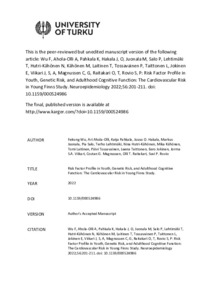Hae
Aineistot 1-8 / 8
Weight gain in infancy and markers of cardiometabolic health in young adulthood
Aim We studied whether repeatedly measured weight gain from birth up to age 2 years associated with cardiometabolic health in young adulthood. Methods Using the data collected in the longitudinal Special Turku Coronary ...
Economic burden of low physical activity and high sedentary behaviour in Finland
<p><strong>Background</strong> Low physical activity and high sedentary behaviour are unquestionably relevant for public health while also increasing direct and indirect costs.</p><p><strong>Methods</strong> The authors ...
IDO activity forecasts obesity in males and premenopausal females in a 10-year follow-up study:The Cardiovascular Risk in Young Finns Study
<p>Background and aims: Indoleamine 2,3-dioxygenase (IDO) is an intracellular enzyme associated with artery wall inflammation. Previous studies have verified correlation between IDO activity and early signs of atherosclerosis especially in females. We aimed to elucidate the relationship between an estimate of IDO activity and atherosclerotic risk factors related to non-alchohol-fatty liver (NAFLD) in a 6- and 10-year follow-up.<br></p><p>Methods: Estimates of IDO activity along with complete risk factor data were measured from females (n = 506; age 24-39) and males (n = 421; age 24-39) in 2001. Risk factor measurements were conducted again in 2007 and 2011. Statistical examinations were carried out by Pearson correlation and risk ratio analysis.<br></p><p>Results: In females, age-adjusted IDO correlated with body mass index (BMI) (p = 0.0008), waist (p = 0.0009), C reactive protein (CRP) (p = 0.0014) and logarithmically modified triglycerides (p = 0.0488) in 2007. Correlation remained significant with BMI (p = 0.0007) and waist (p = 0.0063) in 2011. In males, age-adjusted IDO correlated with waist (p = 0.0367) and high-density lipoprotein cholesterol (HDL-C) (p = 0.0489) in 2007. Correlation remained significant with HDL-C (p = 0.0348) in 2011. In risk ratio analysis, relationship between IDO and obesity was confirmed in females after 10 years (RR = 1.026, p = 0.0147, 95% CI) and in males after 6 and 10 years (RR = 1.019, p = 0.0091, 95% CI and RR = 1.015, p = 0.0404, 95% CI, respectively) when the data was adjusted for age and BMI.Conclusions: IDO activity correlated with obesity and factors related to NAFLD, namely obesity of visceral type, hypertriglyceridemia and CRP (in females), well-characterized risk factors for diabetes and atherosclerosis in 6 and 10-year follow-up in males and premenopausal females.</p>...
Metabolic trajectories in childhood and adolescence: Effects on risk for schizophrenia
<p>Abnormal glucose and lipid metabolism is common in antipsychotic-naive first-episode patients with schizophrenia, but it is unclear whether these changes can already be seen in premorbid or prodromal period, before the first psychotic episode. We examined insulin, total cholesterol, low-density lipoprotein (LDL) cholesterol, high-density lipoprotein (HDL) cholesterol, and triglyceride trajectories in children and adolescents (9-18 years old), who were later diagnosed with schizophrenia, any non-affective psychosis (NAP) or affective disorder (AD). The study population consisted of a general population-based cohort "The Cardiovascular Risk in Young Finns Study", started in 1980 (n=3596). Psychiatric diagnoses were derived from the Health Care Register up to the year 2018. Multivariate statistical analysis indicated no significant differences in insulin or lipid levels in children and adolescents who later developed schizophrenia (n=41) compared to the cohort control group (n=3202). In addition, no changes in these parameters were seen in the NAP (n=74) or AD (n=156) groups compared to the controls, but lower triglyceride levels in childhood/adolescence associated with earlier diagnosis of psychotic disorder in the NAP group. Taken together, our results do not support any gross-level insulin or lipid changes during childhood and adolescence in individuals with later diagnosis of schizophrenia-spectrum disorder. Since changes in glucose and lipid metabolism can be observed in neuroleptic-naive patients with schizophrenia, we hypothesize that the more marked metabolic changes develop during the prodrome closer to the onset of the first psychotic episode. The findings have relevance for studies on developmental hypotheses of schizophrenia.</p>...
Associations of parental physical activity trajectories with offspring's physical activity patterns from childhood to middle adulthood: The Young Finns Study
We investigated the association of parental physical activity (PA) trajectories with offspring's youth and adult PA. Self-reported PA data were extracted from the Young Finns Study with three follow-ups for parents between ...
Risk Factor Profile in Youth, Genetic Risk, and Adulthood Cognitive Function: The Cardiovascular Risk in Young Finns Study
<p>INTRODUCTION</p><p>The role of risk factor profile in childhood and adolescence on adulthood cognitive function and whether it differs by genetic risk is still obscure. To bring this evidence, we determined cognitive ...
Schizophrenia polygenic risk score and long-term success in the labour market: A cohort study
Employment is rare among people with a schizophrenia diagnosis. Meanwhile, a genetic liability for schizophrenia may hinder labour market performance. We studied how the polygenic risk score (PGS) for schizophrenia related ...
Early signs of sleep-disordered breathing in healthy women predict carotid intima-media thickening after 10 years
<p>Background: Cardiovascular disease (CVD) is the leading cause of death in women. The risk of CVD increases in women after menopause. The aim was to study how sleep parameters and cardiovascular risk factors in 46-year-old ...







